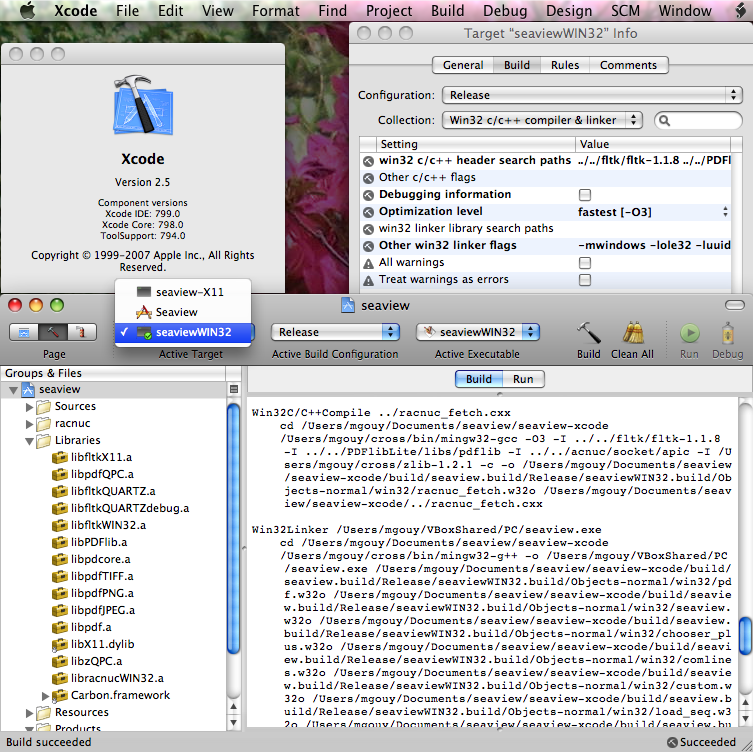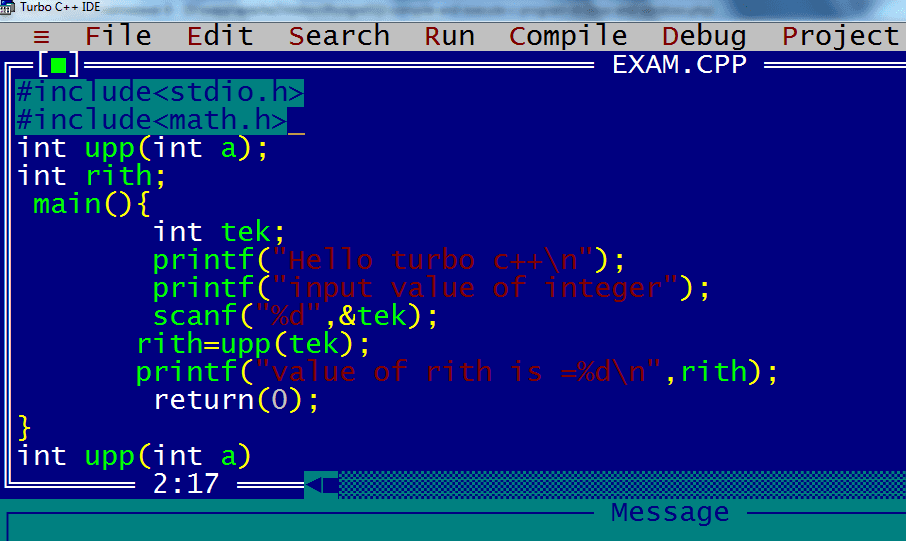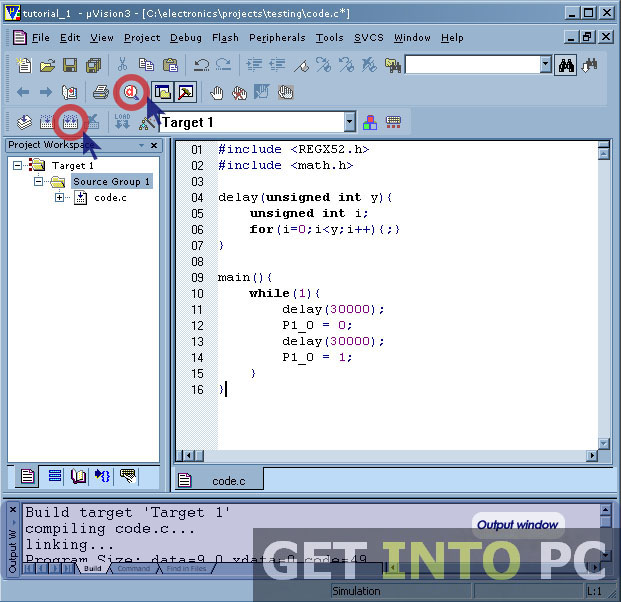Pic C Compiler Full
Posted by admin- in Home -10/10/17A PIC 1. 2F6. 75 tutorial. A tutorial on the 1. F6. 75 PIC microcontroller. LED flasher and progressing on to more advanced projects. To use the tutorial. PIC programmer with an ICSP output connector and the. You dont have to install the compiler as hex file is contained in. If you do want to re compile the source code the compiler is free for the small. Jump to Solderless breadboard. Jump to Circuit diagram. Jump to Software. Before you start have a look at the following for background info 1. F6. 75. The 1. 2F6. It even has a 1. 0bit ADC built in this is the same.  ADC that you can find on the 1. F8. 77. A and 1. 6F8. So. learning about this peripheral is also useful for these other parts. The. 1. 02. 4 words of program memory, 6. Bytes of RAM and 1. Bytes of EEPROM, an. ADC and a comparator. Note The 1. 2F6. ADC. TIP If you need a bit more memory consider using the 1. F6. 83. as this has twice the memory 2. Flash words,1. 28 Bytes SRAM and 2. Bytes. EEPROM compared to the 1. F6. 75. The 1. 2F6. PWM module and an. F6. 75. The 1. 2F6. MHz internal. oscillator 1. F6. 75 has 4. MHz. Pinout Source microchip datasheet1. F6. 75 Microcontroller. Features. The following. F6. 75 in a. visual format Note you can compare this chip using bubble. F6. 75 Microcontroller. Programming. You can program. ICSP programmer you can use it for any PIC chip. ICSP connections are shown in the diagram below. To use it you will need software running on the PC ICPROG. This lets you flash the hex file. F6. 75. You can find a programmer circuit hereand information on using ICPROG here. Note Using the above programmer circuit sometimes. ICSP connector this is easier than removing the whole.
ADC that you can find on the 1. F8. 77. A and 1. 6F8. So. learning about this peripheral is also useful for these other parts. The. 1. 02. 4 words of program memory, 6. Bytes of RAM and 1. Bytes of EEPROM, an. ADC and a comparator. Note The 1. 2F6. ADC. TIP If you need a bit more memory consider using the 1. F6. 83. as this has twice the memory 2. Flash words,1. 28 Bytes SRAM and 2. Bytes. EEPROM compared to the 1. F6. 75. The 1. 2F6. PWM module and an. F6. 75. The 1. 2F6. MHz internal. oscillator 1. F6. 75 has 4. MHz. Pinout Source microchip datasheet1. F6. 75 Microcontroller. Features. The following. F6. 75 in a. visual format Note you can compare this chip using bubble. F6. 75 Microcontroller. Programming. You can program. ICSP programmer you can use it for any PIC chip. ICSP connections are shown in the diagram below. To use it you will need software running on the PC ICPROG. This lets you flash the hex file. F6. 75. You can find a programmer circuit hereand information on using ICPROG here. Note Using the above programmer circuit sometimes. ICSP connector this is easier than removing the whole.  Pic C Compiler Full Metal JacketI have used a 4 pin molex with wires soldered to the base these go into. Sometimes you need to. Vpp PC software operation and at. ICSP pin see temperature logger in a further. F6. 75 ICSP connections 1. F6. 75 pinouts Other views 1. F6. 75 Microcontroller Power Supply. If you dont. have a bench power supply then you should use the following standard. All you will need is a wall power supply block with dc output greater than 8. V. and no more than 3. V or a 9. V battery to plug into CN1. Frequently Asked Questions FAQ about C on the Microchip PIC These are questions which are frequently asked on various Microchip and PICrelated forums which. Options Controlling C Dialect. The following options control the dialect of C that the compiler acceptsansi. Support all ISO C89 programs. This turns off certain.
Pic C Compiler Full Metal JacketI have used a 4 pin molex with wires soldered to the base these go into. Sometimes you need to. Vpp PC software operation and at. ICSP pin see temperature logger in a further. F6. 75 ICSP connections 1. F6. 75 pinouts Other views 1. F6. 75 Microcontroller Power Supply. If you dont. have a bench power supply then you should use the following standard. All you will need is a wall power supply block with dc output greater than 8. V. and no more than 3. V or a 9. V battery to plug into CN1. Frequently Asked Questions FAQ about C on the Microchip PIC These are questions which are frequently asked on various Microchip and PICrelated forums which. Options Controlling C Dialect. The following options control the dialect of C that the compiler acceptsansi. Support all ISO C89 programs. This turns off certain.  Pic C Compiler Full MoonNote It is best to use the 5. V power supply. circuit as it not only correctly regulates the dc voltage but it protects your. PIC chip. The input voltage can go up to 3. V without damaging the 7. You would not want to use that high voltage for very long if using.
Pic C Compiler Full MoonNote It is best to use the 5. V power supply. circuit as it not only correctly regulates the dc voltage but it protects your. PIC chip. The input voltage can go up to 3. V without damaging the 7. You would not want to use that high voltage for very long if using.  Say you used 1. 00m. A dropping 3. 5V to 5. V gives PVx. I 3. W a. huge power output the 7. F6. 75 oscillator calibration value. Before programming it with your hex file make a note of the oscillator. Microchip. Note The calibration value is located at the last. FFThis value calibrates the 4. MHz oscillator to 1. If overwritten you have to. Click here for more detailed information. If you use ICPROG then it warns you that you are about to overwrite the. No to keep the original value. Note Each oscillator calibration value will be. If you loose it you can recalculate it but you will need a frequency counter. Tip for storing the calibration value. This is a tip I have seen on the web for storing your calibration value on. I thought I would include it here. All you do is think of the pins of the 8 pin device as a binary number and mark. All you need is the last hex number as the 1st is always 3. So lets say you read your device and get 3. C. Just use the 8. C part. Oscillator modes. As with the. 1. 6F8. F6. 75 microcontroller has eight oscillator modes but unlike the. F8. 8 the internal oscillator is fixed at 4. Mhz. You can use an external oscillator either a resistor capacitor pair, an. You can even operate the. Mhz if you need extra performance. Note Only use the external modes if. IO pins. is a lot to loose. Tutorial 1 1. 2F6. Flashing an LEDThe first. LED it always is The reason is that there is the. This project also uses the 1. F6. 75s internal oscillator and you dont need a. Use the solderless breadboard to. Note Double check your connections on the. Note the plus sign on the 1. V or greater than your maximum dc power. The LED must be connected with the flat side to ground. Solderless breadboard layout. Circuit diagram. The following diagram. Plugblock circuit in schematic form. It is exactly the same. Plugblock. Note The LED current limiter resistor 1k is not the ideal one it just lets. LED to use the LED at higher output replace it with 2. R. This gives lots. I5 22. 201. A most leds let you use 2. A but. you would have to check the forward diode drop, here assumed as 2. V, to get the. exact resistor. Its only an LED I always assume 2. V as the slight variations. LEDs wont make much difference. Read 1. 2F7. 65. Using ICPROG. F6. 75 and hit the read button. Remember to note down the contents. FF. Software. The next thing to do is. LED to prove that the system you have is working as reading back. Source code files To get the file. You can use the hex. F6. 75 then it will flash the led on and off or. Mikroelectronika. You. can find a very brief compiler tutorial here. Some of the C source code is void. TRISIO 0 set as. Start herevoid main initports while1 infinite. GPIO 1lt lt 4 delayms2. GPIO 0 delayms2. First of all the. GPIO port in common. PIC Micros you can change the port direction at any time. TRIS keyword which is just another register location. Setting a. bit in the TRISIO register to zero sets the pin direction to an output. Here. all bits are zero so all GPIO bits are set as outputs. As you can see main is a very simple easily readable program the only. This just takes the value 1 and bit shifts it left four times so the number 4. Bits in a byte are labeled 7 to 0 from left. If you wanted to set bit 5 you could write GPIO 3. GPIO 1lt lt 5 is much easier to read. Note The C programming course has more on. PORT control techniques. Try changing the. Privacy Policy. About Me. CCS, Inc. CCS C Compilers. CCS developed the first C Compiler for Microchip microcontrollers over 2. PIC MCU and PIC2. PIC DSC devices. CCS compilers are easy to use and quick to learn. For the less experienced programmer, a detailed textbook explaining the C language and how it may be applied to PIC microcontrollers. Our compiler products include pro level optimization, the largest library of built in functions, powerful PIC MCU specific pre processor commands, and ready to run example programs to quickly jump start any project. Our massive customer base provides us access to understanding our customers requirements while developing advanced features with frequent releases and rare bugs. Key Compiler Features Easily migrate between all Microchip PIC MCUs devices. Minimize development time with peripheral drivers and standard C constructs. C style inputoutput streams with full data formatting to any device or for strings. Use CCS libraries and object code royalty free. Convenient functions like bit and byte allow C variables to be placed at absolute addresses. The integral one bit type Short Int permits the compiler to generate very efficient Bit oriented code. Easily define, set up and manage interrupts. Additional Compiler Details.
Say you used 1. 00m. A dropping 3. 5V to 5. V gives PVx. I 3. W a. huge power output the 7. F6. 75 oscillator calibration value. Before programming it with your hex file make a note of the oscillator. Microchip. Note The calibration value is located at the last. FFThis value calibrates the 4. MHz oscillator to 1. If overwritten you have to. Click here for more detailed information. If you use ICPROG then it warns you that you are about to overwrite the. No to keep the original value. Note Each oscillator calibration value will be. If you loose it you can recalculate it but you will need a frequency counter. Tip for storing the calibration value. This is a tip I have seen on the web for storing your calibration value on. I thought I would include it here. All you do is think of the pins of the 8 pin device as a binary number and mark. All you need is the last hex number as the 1st is always 3. So lets say you read your device and get 3. C. Just use the 8. C part. Oscillator modes. As with the. 1. 6F8. F6. 75 microcontroller has eight oscillator modes but unlike the. F8. 8 the internal oscillator is fixed at 4. Mhz. You can use an external oscillator either a resistor capacitor pair, an. You can even operate the. Mhz if you need extra performance. Note Only use the external modes if. IO pins. is a lot to loose. Tutorial 1 1. 2F6. Flashing an LEDThe first. LED it always is The reason is that there is the. This project also uses the 1. F6. 75s internal oscillator and you dont need a. Use the solderless breadboard to. Note Double check your connections on the. Note the plus sign on the 1. V or greater than your maximum dc power. The LED must be connected with the flat side to ground. Solderless breadboard layout. Circuit diagram. The following diagram. Plugblock circuit in schematic form. It is exactly the same. Plugblock. Note The LED current limiter resistor 1k is not the ideal one it just lets. LED to use the LED at higher output replace it with 2. R. This gives lots. I5 22. 201. A most leds let you use 2. A but. you would have to check the forward diode drop, here assumed as 2. V, to get the. exact resistor. Its only an LED I always assume 2. V as the slight variations. LEDs wont make much difference. Read 1. 2F7. 65. Using ICPROG. F6. 75 and hit the read button. Remember to note down the contents. FF. Software. The next thing to do is. LED to prove that the system you have is working as reading back. Source code files To get the file. You can use the hex. F6. 75 then it will flash the led on and off or. Mikroelectronika. You. can find a very brief compiler tutorial here. Some of the C source code is void. TRISIO 0 set as. Start herevoid main initports while1 infinite. GPIO 1lt lt 4 delayms2. GPIO 0 delayms2. First of all the. GPIO port in common. PIC Micros you can change the port direction at any time. TRIS keyword which is just another register location. Setting a. bit in the TRISIO register to zero sets the pin direction to an output. Here. all bits are zero so all GPIO bits are set as outputs. As you can see main is a very simple easily readable program the only. This just takes the value 1 and bit shifts it left four times so the number 4. Bits in a byte are labeled 7 to 0 from left. If you wanted to set bit 5 you could write GPIO 3. GPIO 1lt lt 5 is much easier to read. Note The C programming course has more on. PORT control techniques. Try changing the. Privacy Policy. About Me. CCS, Inc. CCS C Compilers. CCS developed the first C Compiler for Microchip microcontrollers over 2. PIC MCU and PIC2. PIC DSC devices. CCS compilers are easy to use and quick to learn. For the less experienced programmer, a detailed textbook explaining the C language and how it may be applied to PIC microcontrollers. Our compiler products include pro level optimization, the largest library of built in functions, powerful PIC MCU specific pre processor commands, and ready to run example programs to quickly jump start any project. Our massive customer base provides us access to understanding our customers requirements while developing advanced features with frequent releases and rare bugs. Key Compiler Features Easily migrate between all Microchip PIC MCUs devices. Minimize development time with peripheral drivers and standard C constructs. C style inputoutput streams with full data formatting to any device or for strings. Use CCS libraries and object code royalty free. Convenient functions like bit and byte allow C variables to be placed at absolute addresses. The integral one bit type Short Int permits the compiler to generate very efficient Bit oriented code. Easily define, set up and manage interrupts. Additional Compiler Details.